Organization Management in Rapidly Changing Environments Report
VerifiedAdded on 2023/05/30
|16
|3822
|302
Report
AI Summary
This report analyzes how organizations can adapt to rapidly changing technology. It explores management aspects like leadership and change management, establishing their relevance to technological advancements. The study highlights the importance of technological changes in optimizing management processes and analyzes applicable theories. It focuses on critical success factors of leadership, such as strategic planning and situational leadership, and how they contribute to effective organizational change. The report emphasizes the need for organizations to embrace digital transformation and implement change models to systematize operations, ultimately improving business functions and maintaining competitiveness in the face of evolving technologies. This document is a student contribution and more solved assignments can be found on Desklib.
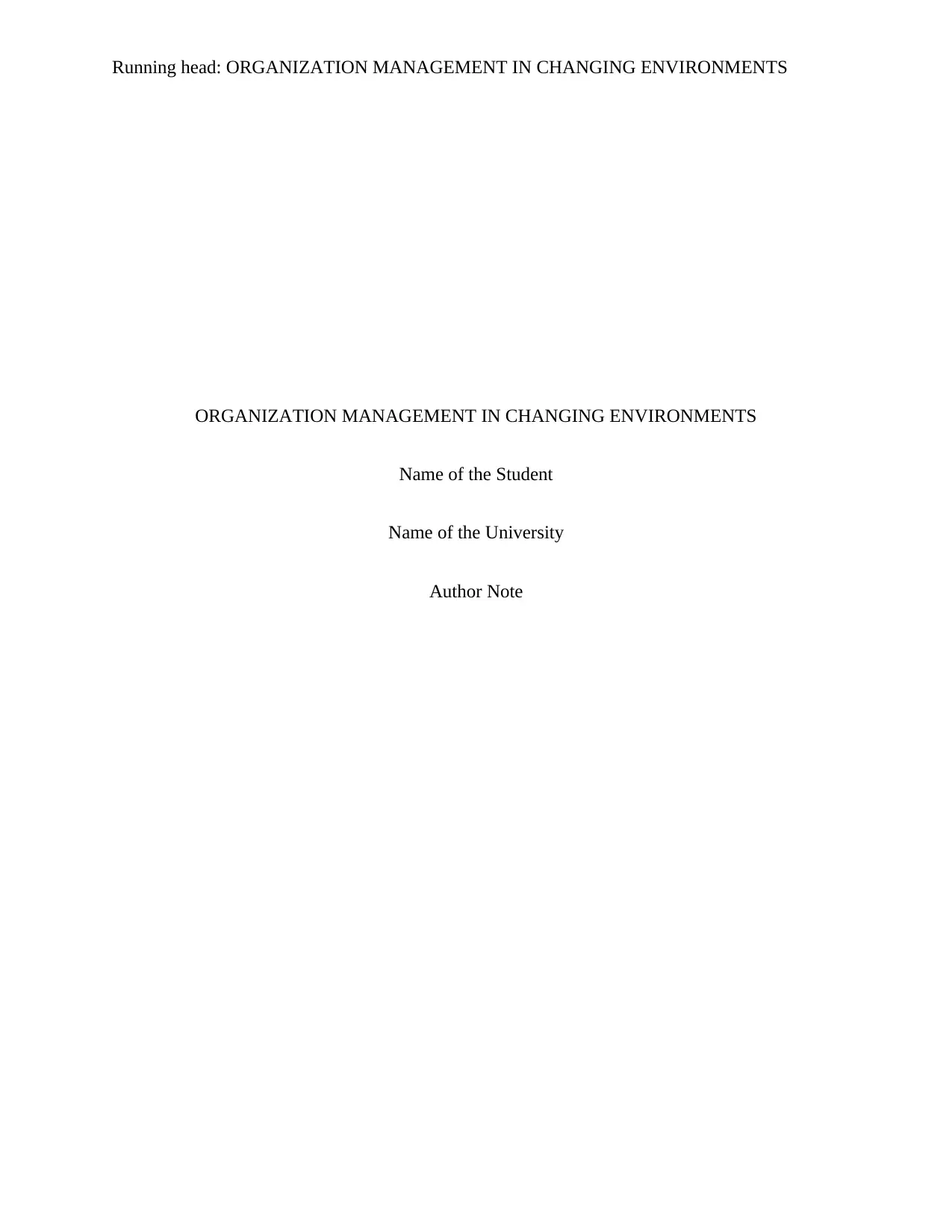
Running head: ORGANIZATION MANAGEMENT IN CHANGING ENVIRONMENTS
ORGANIZATION MANAGEMENT IN CHANGING ENVIRONMENTS
Name of the Student
Name of the University
Author Note
ORGANIZATION MANAGEMENT IN CHANGING ENVIRONMENTS
Name of the Student
Name of the University
Author Note
Paraphrase This Document
Need a fresh take? Get an instant paraphrase of this document with our AI Paraphraser
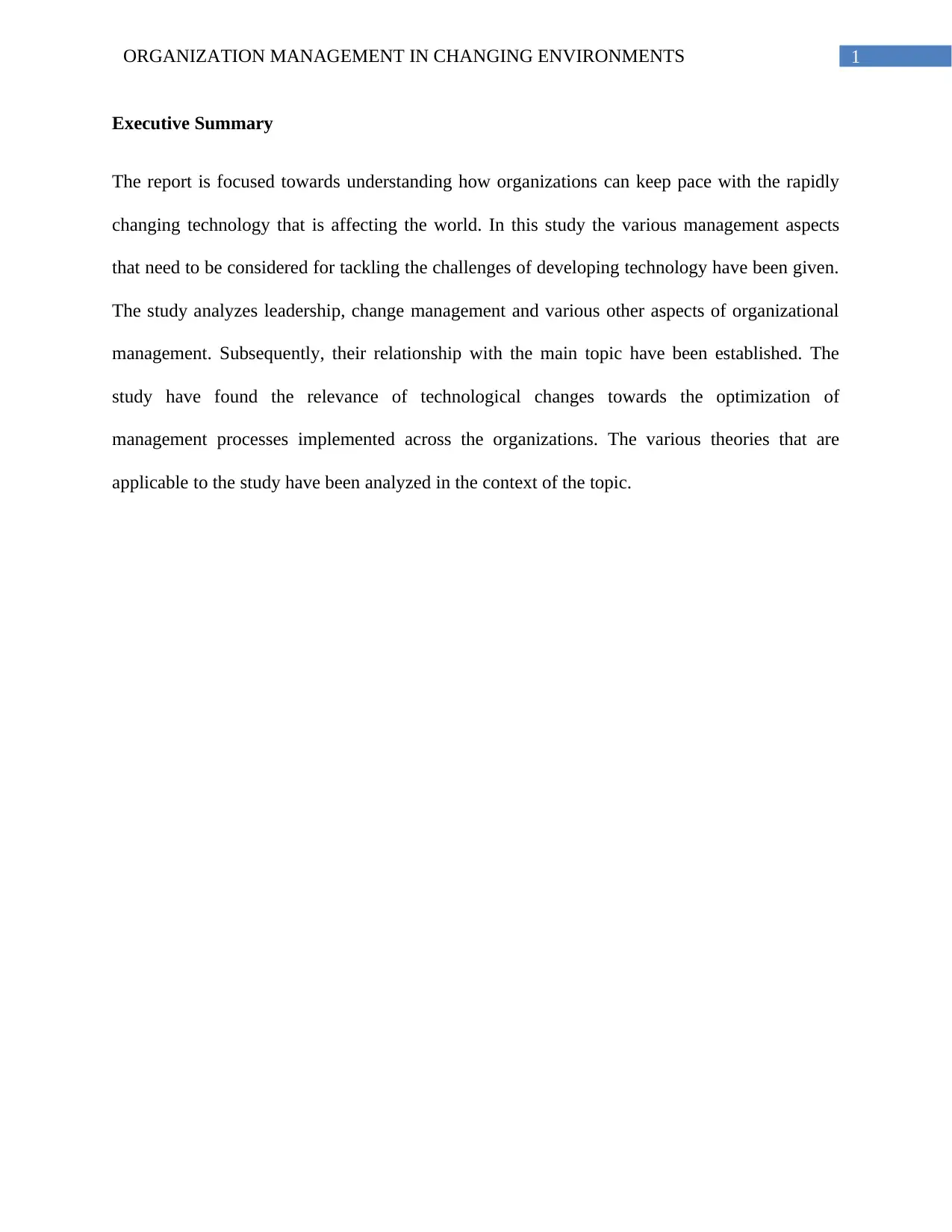
1ORGANIZATION MANAGEMENT IN CHANGING ENVIRONMENTS
Executive Summary
The report is focused towards understanding how organizations can keep pace with the rapidly
changing technology that is affecting the world. In this study the various management aspects
that need to be considered for tackling the challenges of developing technology have been given.
The study analyzes leadership, change management and various other aspects of organizational
management. Subsequently, their relationship with the main topic have been established. The
study have found the relevance of technological changes towards the optimization of
management processes implemented across the organizations. The various theories that are
applicable to the study have been analyzed in the context of the topic.
Executive Summary
The report is focused towards understanding how organizations can keep pace with the rapidly
changing technology that is affecting the world. In this study the various management aspects
that need to be considered for tackling the challenges of developing technology have been given.
The study analyzes leadership, change management and various other aspects of organizational
management. Subsequently, their relationship with the main topic have been established. The
study have found the relevance of technological changes towards the optimization of
management processes implemented across the organizations. The various theories that are
applicable to the study have been analyzed in the context of the topic.
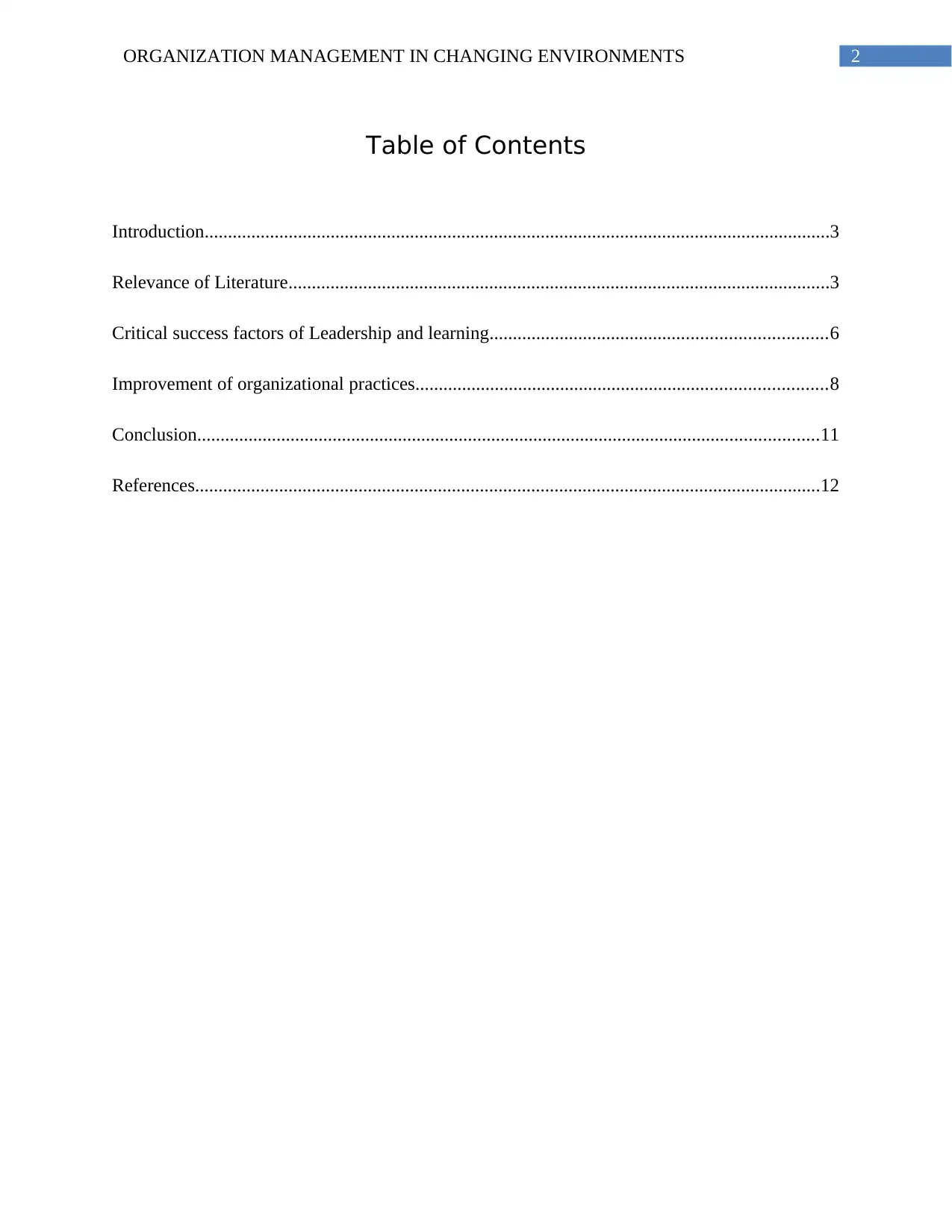
2ORGANIZATION MANAGEMENT IN CHANGING ENVIRONMENTS
Table of Contents
Introduction......................................................................................................................................3
Relevance of Literature....................................................................................................................3
Critical success factors of Leadership and learning........................................................................6
Improvement of organizational practices........................................................................................8
Conclusion.....................................................................................................................................11
References......................................................................................................................................12
Table of Contents
Introduction......................................................................................................................................3
Relevance of Literature....................................................................................................................3
Critical success factors of Leadership and learning........................................................................6
Improvement of organizational practices........................................................................................8
Conclusion.....................................................................................................................................11
References......................................................................................................................................12
⊘ This is a preview!⊘
Do you want full access?
Subscribe today to unlock all pages.

Trusted by 1+ million students worldwide
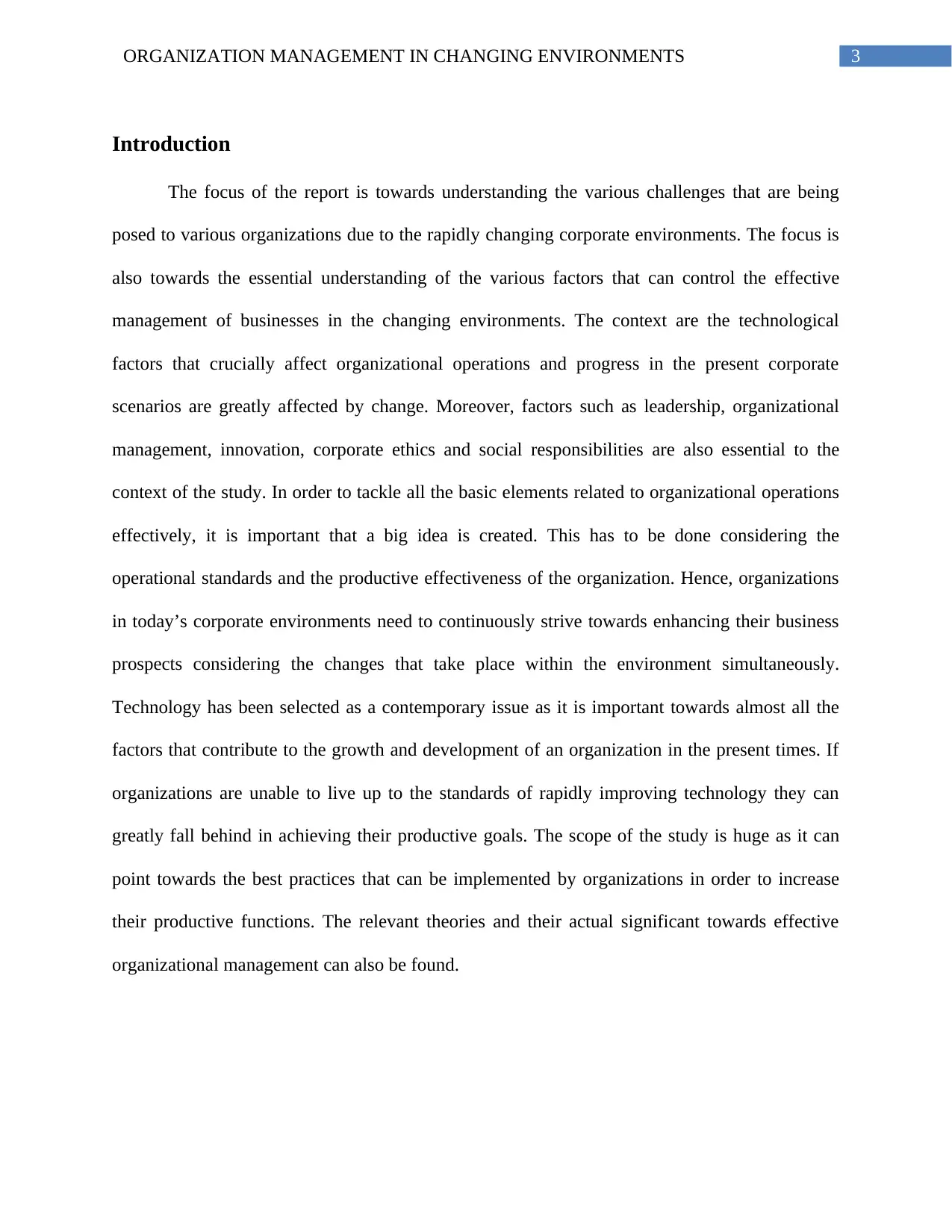
3ORGANIZATION MANAGEMENT IN CHANGING ENVIRONMENTS
Introduction
The focus of the report is towards understanding the various challenges that are being
posed to various organizations due to the rapidly changing corporate environments. The focus is
also towards the essential understanding of the various factors that can control the effective
management of businesses in the changing environments. The context are the technological
factors that crucially affect organizational operations and progress in the present corporate
scenarios are greatly affected by change. Moreover, factors such as leadership, organizational
management, innovation, corporate ethics and social responsibilities are also essential to the
context of the study. In order to tackle all the basic elements related to organizational operations
effectively, it is important that a big idea is created. This has to be done considering the
operational standards and the productive effectiveness of the organization. Hence, organizations
in today’s corporate environments need to continuously strive towards enhancing their business
prospects considering the changes that take place within the environment simultaneously.
Technology has been selected as a contemporary issue as it is important towards almost all the
factors that contribute to the growth and development of an organization in the present times. If
organizations are unable to live up to the standards of rapidly improving technology they can
greatly fall behind in achieving their productive goals. The scope of the study is huge as it can
point towards the best practices that can be implemented by organizations in order to increase
their productive functions. The relevant theories and their actual significant towards effective
organizational management can also be found.
Introduction
The focus of the report is towards understanding the various challenges that are being
posed to various organizations due to the rapidly changing corporate environments. The focus is
also towards the essential understanding of the various factors that can control the effective
management of businesses in the changing environments. The context are the technological
factors that crucially affect organizational operations and progress in the present corporate
scenarios are greatly affected by change. Moreover, factors such as leadership, organizational
management, innovation, corporate ethics and social responsibilities are also essential to the
context of the study. In order to tackle all the basic elements related to organizational operations
effectively, it is important that a big idea is created. This has to be done considering the
operational standards and the productive effectiveness of the organization. Hence, organizations
in today’s corporate environments need to continuously strive towards enhancing their business
prospects considering the changes that take place within the environment simultaneously.
Technology has been selected as a contemporary issue as it is important towards almost all the
factors that contribute to the growth and development of an organization in the present times. If
organizations are unable to live up to the standards of rapidly improving technology they can
greatly fall behind in achieving their productive goals. The scope of the study is huge as it can
point towards the best practices that can be implemented by organizations in order to increase
their productive functions. The relevant theories and their actual significant towards effective
organizational management can also be found.
Paraphrase This Document
Need a fresh take? Get an instant paraphrase of this document with our AI Paraphraser
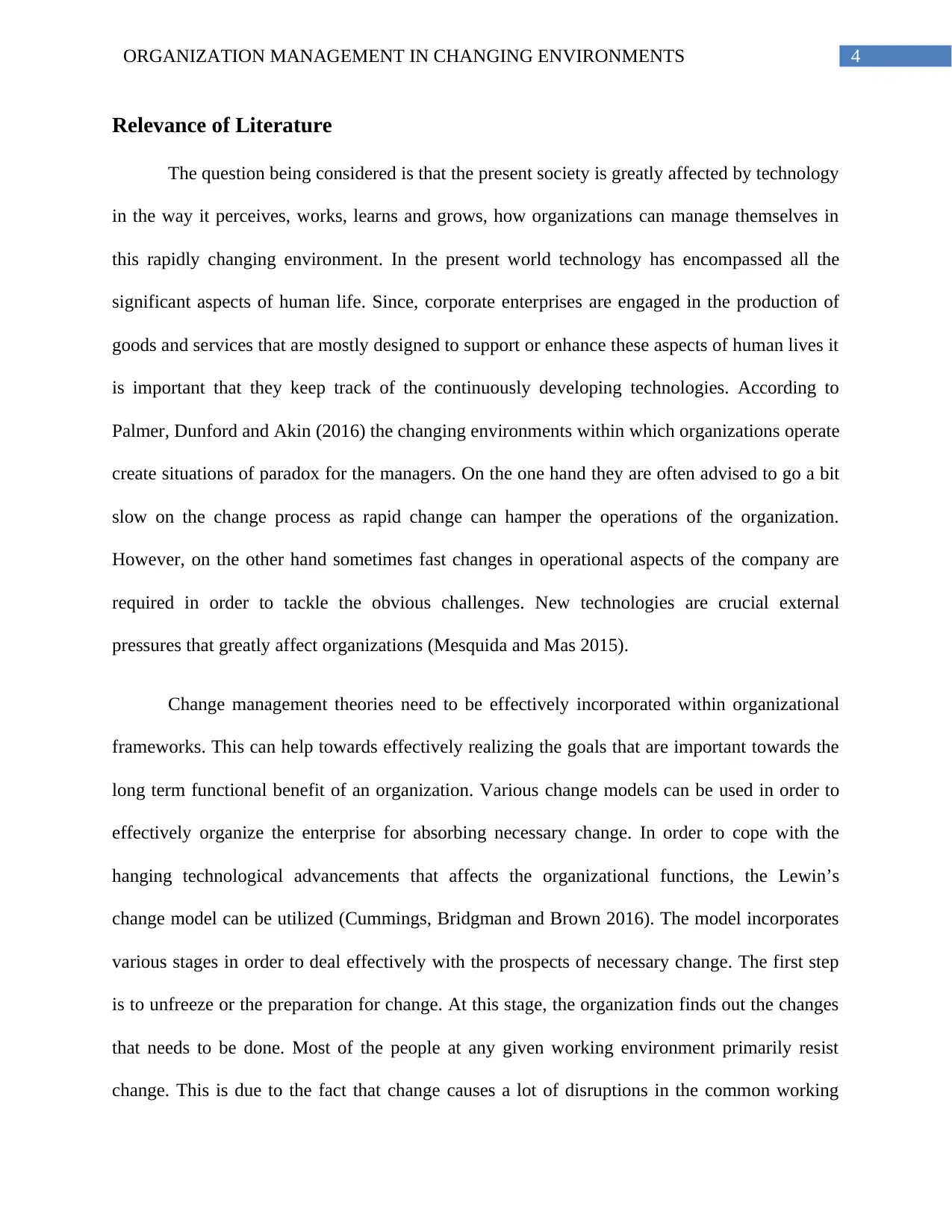
4ORGANIZATION MANAGEMENT IN CHANGING ENVIRONMENTS
Relevance of Literature
The question being considered is that the present society is greatly affected by technology
in the way it perceives, works, learns and grows, how organizations can manage themselves in
this rapidly changing environment. In the present world technology has encompassed all the
significant aspects of human life. Since, corporate enterprises are engaged in the production of
goods and services that are mostly designed to support or enhance these aspects of human lives it
is important that they keep track of the continuously developing technologies. According to
Palmer, Dunford and Akin (2016) the changing environments within which organizations operate
create situations of paradox for the managers. On the one hand they are often advised to go a bit
slow on the change process as rapid change can hamper the operations of the organization.
However, on the other hand sometimes fast changes in operational aspects of the company are
required in order to tackle the obvious challenges. New technologies are crucial external
pressures that greatly affect organizations (Mesquida and Mas 2015).
Change management theories need to be effectively incorporated within organizational
frameworks. This can help towards effectively realizing the goals that are important towards the
long term functional benefit of an organization. Various change models can be used in order to
effectively organize the enterprise for absorbing necessary change. In order to cope with the
hanging technological advancements that affects the organizational functions, the Lewin’s
change model can be utilized (Cummings, Bridgman and Brown 2016). The model incorporates
various stages in order to deal effectively with the prospects of necessary change. The first step
is to unfreeze or the preparation for change. At this stage, the organization finds out the changes
that needs to be done. Most of the people at any given working environment primarily resist
change. This is due to the fact that change causes a lot of disruptions in the common working
Relevance of Literature
The question being considered is that the present society is greatly affected by technology
in the way it perceives, works, learns and grows, how organizations can manage themselves in
this rapidly changing environment. In the present world technology has encompassed all the
significant aspects of human life. Since, corporate enterprises are engaged in the production of
goods and services that are mostly designed to support or enhance these aspects of human lives it
is important that they keep track of the continuously developing technologies. According to
Palmer, Dunford and Akin (2016) the changing environments within which organizations operate
create situations of paradox for the managers. On the one hand they are often advised to go a bit
slow on the change process as rapid change can hamper the operations of the organization.
However, on the other hand sometimes fast changes in operational aspects of the company are
required in order to tackle the obvious challenges. New technologies are crucial external
pressures that greatly affect organizations (Mesquida and Mas 2015).
Change management theories need to be effectively incorporated within organizational
frameworks. This can help towards effectively realizing the goals that are important towards the
long term functional benefit of an organization. Various change models can be used in order to
effectively organize the enterprise for absorbing necessary change. In order to cope with the
hanging technological advancements that affects the organizational functions, the Lewin’s
change model can be utilized (Cummings, Bridgman and Brown 2016). The model incorporates
various stages in order to deal effectively with the prospects of necessary change. The first step
is to unfreeze or the preparation for change. At this stage, the organization finds out the changes
that needs to be done. Most of the people at any given working environment primarily resist
change. This is due to the fact that change causes a lot of disruptions in the common working
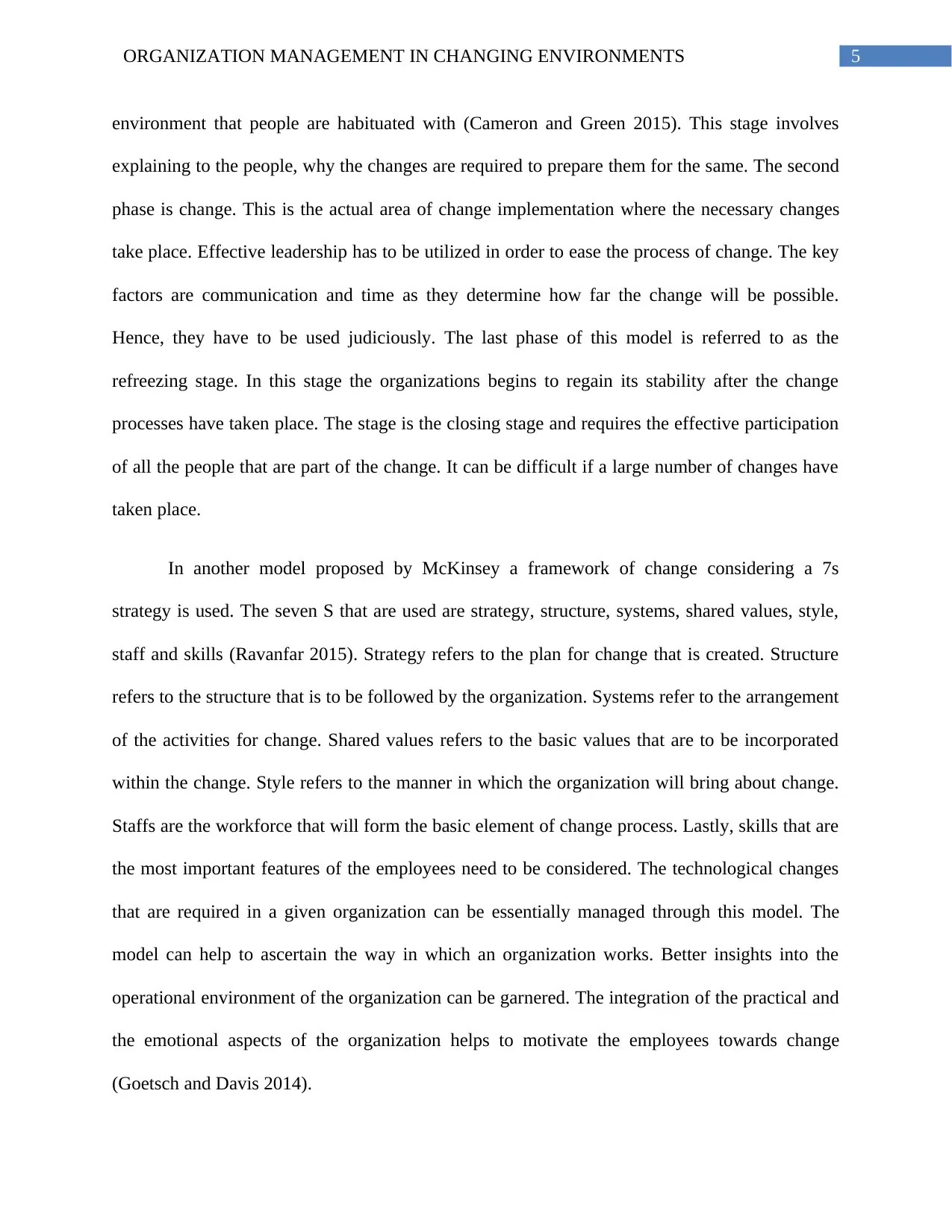
5ORGANIZATION MANAGEMENT IN CHANGING ENVIRONMENTS
environment that people are habituated with (Cameron and Green 2015). This stage involves
explaining to the people, why the changes are required to prepare them for the same. The second
phase is change. This is the actual area of change implementation where the necessary changes
take place. Effective leadership has to be utilized in order to ease the process of change. The key
factors are communication and time as they determine how far the change will be possible.
Hence, they have to be used judiciously. The last phase of this model is referred to as the
refreezing stage. In this stage the organizations begins to regain its stability after the change
processes have taken place. The stage is the closing stage and requires the effective participation
of all the people that are part of the change. It can be difficult if a large number of changes have
taken place.
In another model proposed by McKinsey a framework of change considering a 7s
strategy is used. The seven S that are used are strategy, structure, systems, shared values, style,
staff and skills (Ravanfar 2015). Strategy refers to the plan for change that is created. Structure
refers to the structure that is to be followed by the organization. Systems refer to the arrangement
of the activities for change. Shared values refers to the basic values that are to be incorporated
within the change. Style refers to the manner in which the organization will bring about change.
Staffs are the workforce that will form the basic element of change process. Lastly, skills that are
the most important features of the employees need to be considered. The technological changes
that are required in a given organization can be essentially managed through this model. The
model can help to ascertain the way in which an organization works. Better insights into the
operational environment of the organization can be garnered. The integration of the practical and
the emotional aspects of the organization helps to motivate the employees towards change
(Goetsch and Davis 2014).
environment that people are habituated with (Cameron and Green 2015). This stage involves
explaining to the people, why the changes are required to prepare them for the same. The second
phase is change. This is the actual area of change implementation where the necessary changes
take place. Effective leadership has to be utilized in order to ease the process of change. The key
factors are communication and time as they determine how far the change will be possible.
Hence, they have to be used judiciously. The last phase of this model is referred to as the
refreezing stage. In this stage the organizations begins to regain its stability after the change
processes have taken place. The stage is the closing stage and requires the effective participation
of all the people that are part of the change. It can be difficult if a large number of changes have
taken place.
In another model proposed by McKinsey a framework of change considering a 7s
strategy is used. The seven S that are used are strategy, structure, systems, shared values, style,
staff and skills (Ravanfar 2015). Strategy refers to the plan for change that is created. Structure
refers to the structure that is to be followed by the organization. Systems refer to the arrangement
of the activities for change. Shared values refers to the basic values that are to be incorporated
within the change. Style refers to the manner in which the organization will bring about change.
Staffs are the workforce that will form the basic element of change process. Lastly, skills that are
the most important features of the employees need to be considered. The technological changes
that are required in a given organization can be essentially managed through this model. The
model can help to ascertain the way in which an organization works. Better insights into the
operational environment of the organization can be garnered. The integration of the practical and
the emotional aspects of the organization helps to motivate the employees towards change
(Goetsch and Davis 2014).
⊘ This is a preview!⊘
Do you want full access?
Subscribe today to unlock all pages.

Trusted by 1+ million students worldwide
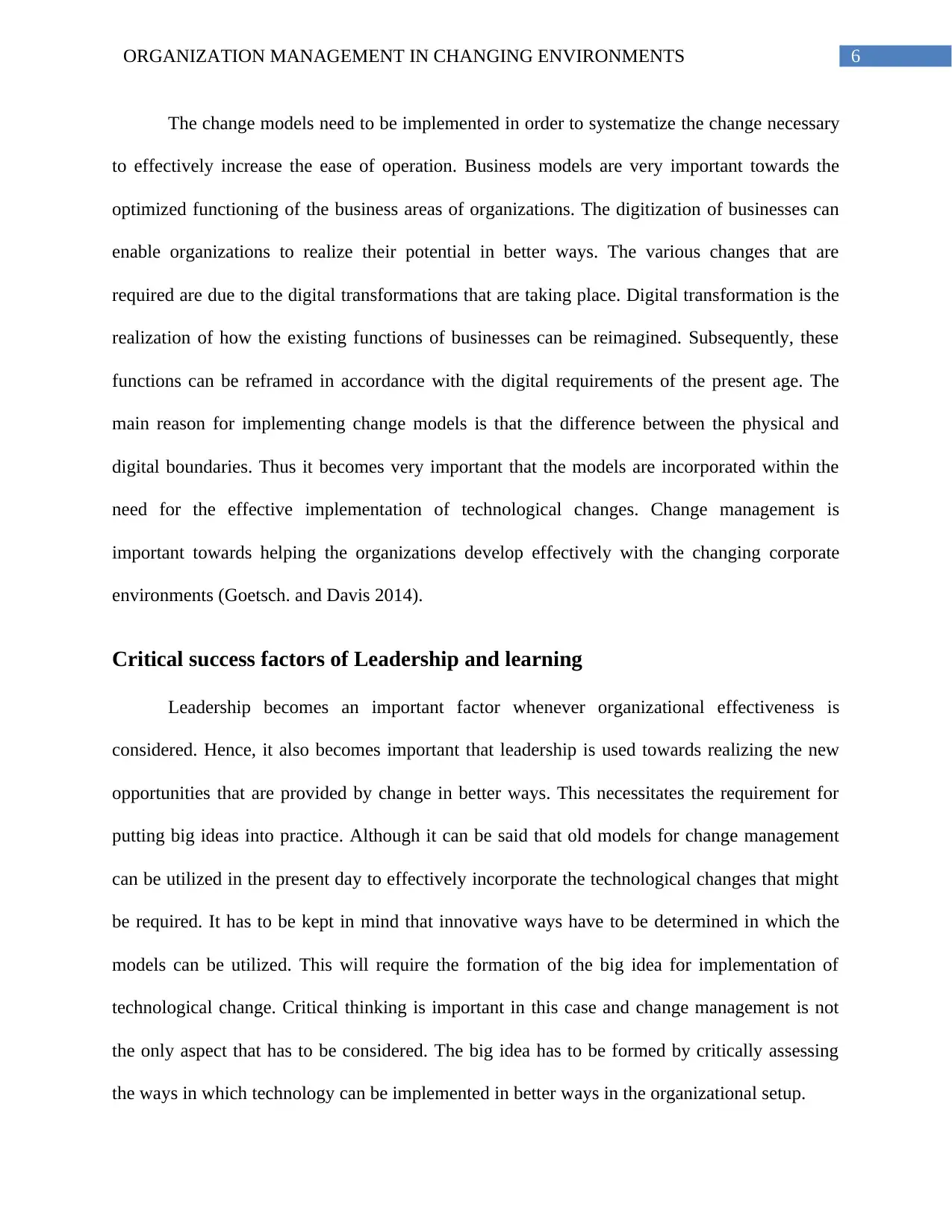
6ORGANIZATION MANAGEMENT IN CHANGING ENVIRONMENTS
The change models need to be implemented in order to systematize the change necessary
to effectively increase the ease of operation. Business models are very important towards the
optimized functioning of the business areas of organizations. The digitization of businesses can
enable organizations to realize their potential in better ways. The various changes that are
required are due to the digital transformations that are taking place. Digital transformation is the
realization of how the existing functions of businesses can be reimagined. Subsequently, these
functions can be reframed in accordance with the digital requirements of the present age. The
main reason for implementing change models is that the difference between the physical and
digital boundaries. Thus it becomes very important that the models are incorporated within the
need for the effective implementation of technological changes. Change management is
important towards helping the organizations develop effectively with the changing corporate
environments (Goetsch. and Davis 2014).
Critical success factors of Leadership and learning
Leadership becomes an important factor whenever organizational effectiveness is
considered. Hence, it also becomes important that leadership is used towards realizing the new
opportunities that are provided by change in better ways. This necessitates the requirement for
putting big ideas into practice. Although it can be said that old models for change management
can be utilized in the present day to effectively incorporate the technological changes that might
be required. It has to be kept in mind that innovative ways have to be determined in which the
models can be utilized. This will require the formation of the big idea for implementation of
technological change. Critical thinking is important in this case and change management is not
the only aspect that has to be considered. The big idea has to be formed by critically assessing
the ways in which technology can be implemented in better ways in the organizational setup.
The change models need to be implemented in order to systematize the change necessary
to effectively increase the ease of operation. Business models are very important towards the
optimized functioning of the business areas of organizations. The digitization of businesses can
enable organizations to realize their potential in better ways. The various changes that are
required are due to the digital transformations that are taking place. Digital transformation is the
realization of how the existing functions of businesses can be reimagined. Subsequently, these
functions can be reframed in accordance with the digital requirements of the present age. The
main reason for implementing change models is that the difference between the physical and
digital boundaries. Thus it becomes very important that the models are incorporated within the
need for the effective implementation of technological changes. Change management is
important towards helping the organizations develop effectively with the changing corporate
environments (Goetsch. and Davis 2014).
Critical success factors of Leadership and learning
Leadership becomes an important factor whenever organizational effectiveness is
considered. Hence, it also becomes important that leadership is used towards realizing the new
opportunities that are provided by change in better ways. This necessitates the requirement for
putting big ideas into practice. Although it can be said that old models for change management
can be utilized in the present day to effectively incorporate the technological changes that might
be required. It has to be kept in mind that innovative ways have to be determined in which the
models can be utilized. This will require the formation of the big idea for implementation of
technological change. Critical thinking is important in this case and change management is not
the only aspect that has to be considered. The big idea has to be formed by critically assessing
the ways in which technology can be implemented in better ways in the organizational setup.
Paraphrase This Document
Need a fresh take? Get an instant paraphrase of this document with our AI Paraphraser
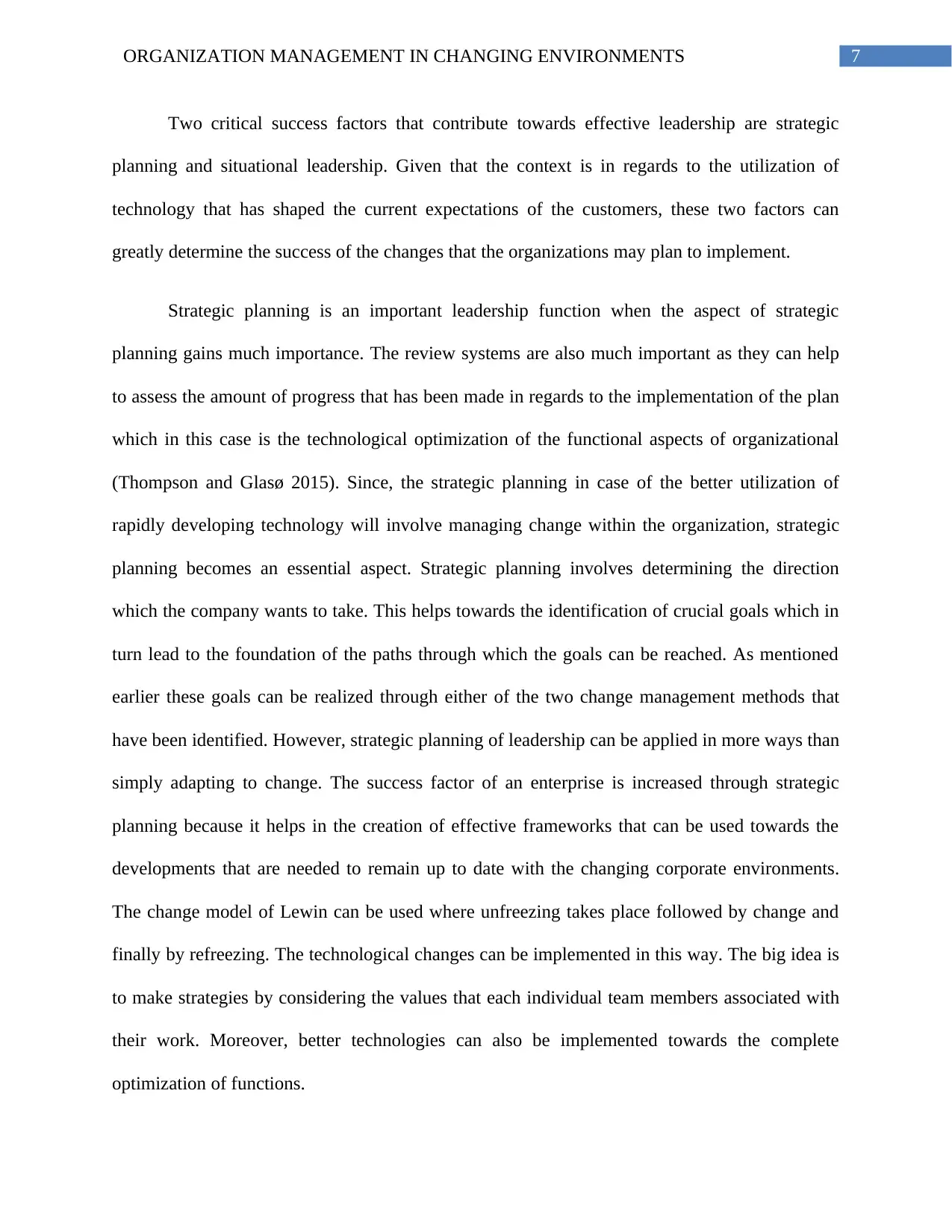
7ORGANIZATION MANAGEMENT IN CHANGING ENVIRONMENTS
Two critical success factors that contribute towards effective leadership are strategic
planning and situational leadership. Given that the context is in regards to the utilization of
technology that has shaped the current expectations of the customers, these two factors can
greatly determine the success of the changes that the organizations may plan to implement.
Strategic planning is an important leadership function when the aspect of strategic
planning gains much importance. The review systems are also much important as they can help
to assess the amount of progress that has been made in regards to the implementation of the plan
which in this case is the technological optimization of the functional aspects of organizational
(Thompson and Glasø 2015). Since, the strategic planning in case of the better utilization of
rapidly developing technology will involve managing change within the organization, strategic
planning becomes an essential aspect. Strategic planning involves determining the direction
which the company wants to take. This helps towards the identification of crucial goals which in
turn lead to the foundation of the paths through which the goals can be reached. As mentioned
earlier these goals can be realized through either of the two change management methods that
have been identified. However, strategic planning of leadership can be applied in more ways than
simply adapting to change. The success factor of an enterprise is increased through strategic
planning because it helps in the creation of effective frameworks that can be used towards the
developments that are needed to remain up to date with the changing corporate environments.
The change model of Lewin can be used where unfreezing takes place followed by change and
finally by refreezing. The technological changes can be implemented in this way. The big idea is
to make strategies by considering the values that each individual team members associated with
their work. Moreover, better technologies can also be implemented towards the complete
optimization of functions.
Two critical success factors that contribute towards effective leadership are strategic
planning and situational leadership. Given that the context is in regards to the utilization of
technology that has shaped the current expectations of the customers, these two factors can
greatly determine the success of the changes that the organizations may plan to implement.
Strategic planning is an important leadership function when the aspect of strategic
planning gains much importance. The review systems are also much important as they can help
to assess the amount of progress that has been made in regards to the implementation of the plan
which in this case is the technological optimization of the functional aspects of organizational
(Thompson and Glasø 2015). Since, the strategic planning in case of the better utilization of
rapidly developing technology will involve managing change within the organization, strategic
planning becomes an essential aspect. Strategic planning involves determining the direction
which the company wants to take. This helps towards the identification of crucial goals which in
turn lead to the foundation of the paths through which the goals can be reached. As mentioned
earlier these goals can be realized through either of the two change management methods that
have been identified. However, strategic planning of leadership can be applied in more ways than
simply adapting to change. The success factor of an enterprise is increased through strategic
planning because it helps in the creation of effective frameworks that can be used towards the
developments that are needed to remain up to date with the changing corporate environments.
The change model of Lewin can be used where unfreezing takes place followed by change and
finally by refreezing. The technological changes can be implemented in this way. The big idea is
to make strategies by considering the values that each individual team members associated with
their work. Moreover, better technologies can also be implemented towards the complete
optimization of functions.
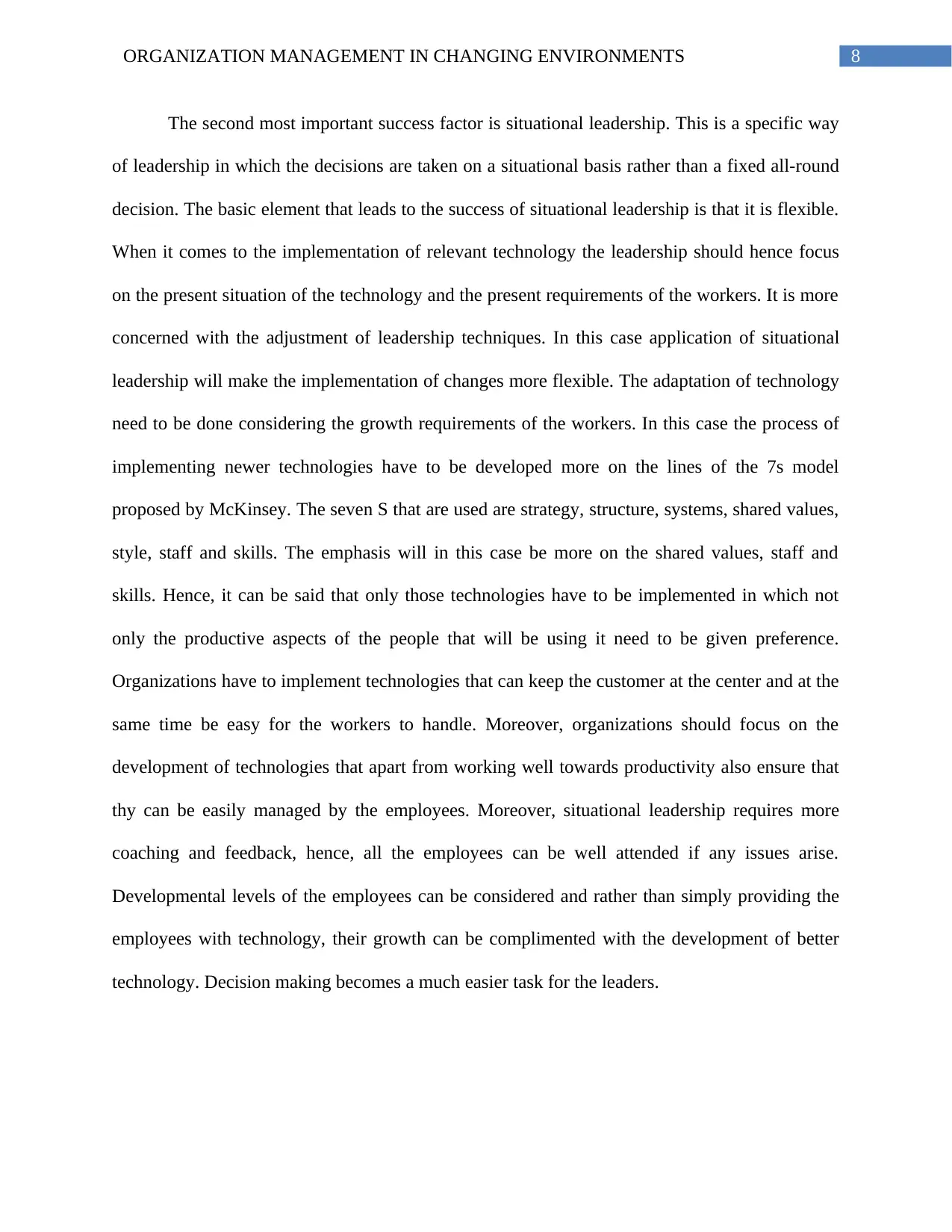
8ORGANIZATION MANAGEMENT IN CHANGING ENVIRONMENTS
The second most important success factor is situational leadership. This is a specific way
of leadership in which the decisions are taken on a situational basis rather than a fixed all-round
decision. The basic element that leads to the success of situational leadership is that it is flexible.
When it comes to the implementation of relevant technology the leadership should hence focus
on the present situation of the technology and the present requirements of the workers. It is more
concerned with the adjustment of leadership techniques. In this case application of situational
leadership will make the implementation of changes more flexible. The adaptation of technology
need to be done considering the growth requirements of the workers. In this case the process of
implementing newer technologies have to be developed more on the lines of the 7s model
proposed by McKinsey. The seven S that are used are strategy, structure, systems, shared values,
style, staff and skills. The emphasis will in this case be more on the shared values, staff and
skills. Hence, it can be said that only those technologies have to be implemented in which not
only the productive aspects of the people that will be using it need to be given preference.
Organizations have to implement technologies that can keep the customer at the center and at the
same time be easy for the workers to handle. Moreover, organizations should focus on the
development of technologies that apart from working well towards productivity also ensure that
thy can be easily managed by the employees. Moreover, situational leadership requires more
coaching and feedback, hence, all the employees can be well attended if any issues arise.
Developmental levels of the employees can be considered and rather than simply providing the
employees with technology, their growth can be complimented with the development of better
technology. Decision making becomes a much easier task for the leaders.
The second most important success factor is situational leadership. This is a specific way
of leadership in which the decisions are taken on a situational basis rather than a fixed all-round
decision. The basic element that leads to the success of situational leadership is that it is flexible.
When it comes to the implementation of relevant technology the leadership should hence focus
on the present situation of the technology and the present requirements of the workers. It is more
concerned with the adjustment of leadership techniques. In this case application of situational
leadership will make the implementation of changes more flexible. The adaptation of technology
need to be done considering the growth requirements of the workers. In this case the process of
implementing newer technologies have to be developed more on the lines of the 7s model
proposed by McKinsey. The seven S that are used are strategy, structure, systems, shared values,
style, staff and skills. The emphasis will in this case be more on the shared values, staff and
skills. Hence, it can be said that only those technologies have to be implemented in which not
only the productive aspects of the people that will be using it need to be given preference.
Organizations have to implement technologies that can keep the customer at the center and at the
same time be easy for the workers to handle. Moreover, organizations should focus on the
development of technologies that apart from working well towards productivity also ensure that
thy can be easily managed by the employees. Moreover, situational leadership requires more
coaching and feedback, hence, all the employees can be well attended if any issues arise.
Developmental levels of the employees can be considered and rather than simply providing the
employees with technology, their growth can be complimented with the development of better
technology. Decision making becomes a much easier task for the leaders.
⊘ This is a preview!⊘
Do you want full access?
Subscribe today to unlock all pages.

Trusted by 1+ million students worldwide
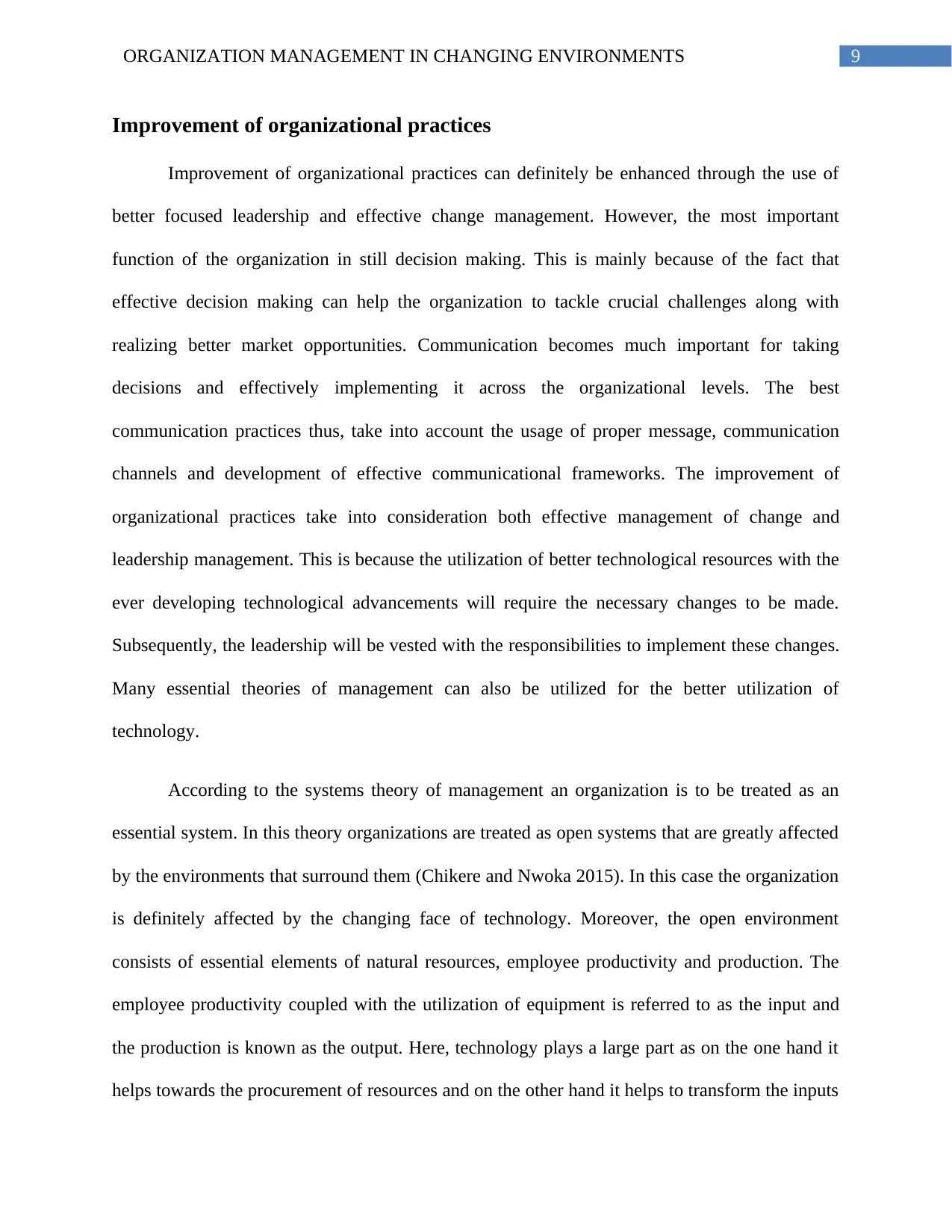
9ORGANIZATION MANAGEMENT IN CHANGING ENVIRONMENTS
Improvement of organizational practices
Improvement of organizational practices can definitely be enhanced through the use of
better focused leadership and effective change management. However, the most important
function of the organization in still decision making. This is mainly because of the fact that
effective decision making can help the organization to tackle crucial challenges along with
realizing better market opportunities. Communication becomes much important for taking
decisions and effectively implementing it across the organizational levels. The best
communication practices thus, take into account the usage of proper message, communication
channels and development of effective communicational frameworks. The improvement of
organizational practices take into consideration both effective management of change and
leadership management. This is because the utilization of better technological resources with the
ever developing technological advancements will require the necessary changes to be made.
Subsequently, the leadership will be vested with the responsibilities to implement these changes.
Many essential theories of management can also be utilized for the better utilization of
technology.
According to the systems theory of management an organization is to be treated as an
essential system. In this theory organizations are treated as open systems that are greatly affected
by the environments that surround them (Chikere and Nwoka 2015). In this case the organization
is definitely affected by the changing face of technology. Moreover, the open environment
consists of essential elements of natural resources, employee productivity and production. The
employee productivity coupled with the utilization of equipment is referred to as the input and
the production is known as the output. Here, technology plays a large part as on the one hand it
helps towards the procurement of resources and on the other hand it helps to transform the inputs
Improvement of organizational practices
Improvement of organizational practices can definitely be enhanced through the use of
better focused leadership and effective change management. However, the most important
function of the organization in still decision making. This is mainly because of the fact that
effective decision making can help the organization to tackle crucial challenges along with
realizing better market opportunities. Communication becomes much important for taking
decisions and effectively implementing it across the organizational levels. The best
communication practices thus, take into account the usage of proper message, communication
channels and development of effective communicational frameworks. The improvement of
organizational practices take into consideration both effective management of change and
leadership management. This is because the utilization of better technological resources with the
ever developing technological advancements will require the necessary changes to be made.
Subsequently, the leadership will be vested with the responsibilities to implement these changes.
Many essential theories of management can also be utilized for the better utilization of
technology.
According to the systems theory of management an organization is to be treated as an
essential system. In this theory organizations are treated as open systems that are greatly affected
by the environments that surround them (Chikere and Nwoka 2015). In this case the organization
is definitely affected by the changing face of technology. Moreover, the open environment
consists of essential elements of natural resources, employee productivity and production. The
employee productivity coupled with the utilization of equipment is referred to as the input and
the production is known as the output. Here, technology plays a large part as on the one hand it
helps towards the procurement of resources and on the other hand it helps to transform the inputs
Paraphrase This Document
Need a fresh take? Get an instant paraphrase of this document with our AI Paraphraser
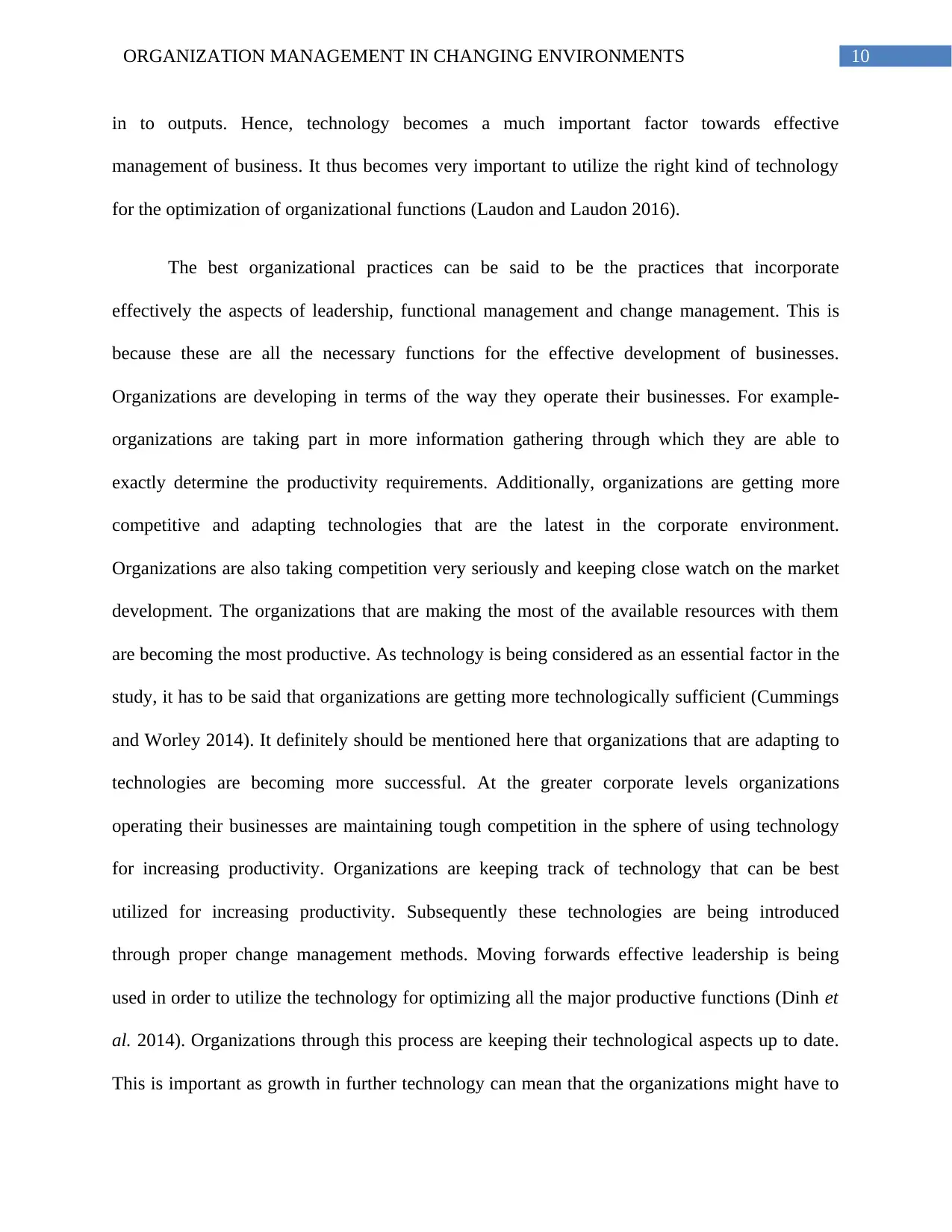
10ORGANIZATION MANAGEMENT IN CHANGING ENVIRONMENTS
in to outputs. Hence, technology becomes a much important factor towards effective
management of business. It thus becomes very important to utilize the right kind of technology
for the optimization of organizational functions (Laudon and Laudon 2016).
The best organizational practices can be said to be the practices that incorporate
effectively the aspects of leadership, functional management and change management. This is
because these are all the necessary functions for the effective development of businesses.
Organizations are developing in terms of the way they operate their businesses. For example-
organizations are taking part in more information gathering through which they are able to
exactly determine the productivity requirements. Additionally, organizations are getting more
competitive and adapting technologies that are the latest in the corporate environment.
Organizations are also taking competition very seriously and keeping close watch on the market
development. The organizations that are making the most of the available resources with them
are becoming the most productive. As technology is being considered as an essential factor in the
study, it has to be said that organizations are getting more technologically sufficient (Cummings
and Worley 2014). It definitely should be mentioned here that organizations that are adapting to
technologies are becoming more successful. At the greater corporate levels organizations
operating their businesses are maintaining tough competition in the sphere of using technology
for increasing productivity. Organizations are keeping track of technology that can be best
utilized for increasing productivity. Subsequently these technologies are being introduced
through proper change management methods. Moving forwards effective leadership is being
used in order to utilize the technology for optimizing all the major productive functions (Dinh et
al. 2014). Organizations through this process are keeping their technological aspects up to date.
This is important as growth in further technology can mean that the organizations might have to
in to outputs. Hence, technology becomes a much important factor towards effective
management of business. It thus becomes very important to utilize the right kind of technology
for the optimization of organizational functions (Laudon and Laudon 2016).
The best organizational practices can be said to be the practices that incorporate
effectively the aspects of leadership, functional management and change management. This is
because these are all the necessary functions for the effective development of businesses.
Organizations are developing in terms of the way they operate their businesses. For example-
organizations are taking part in more information gathering through which they are able to
exactly determine the productivity requirements. Additionally, organizations are getting more
competitive and adapting technologies that are the latest in the corporate environment.
Organizations are also taking competition very seriously and keeping close watch on the market
development. The organizations that are making the most of the available resources with them
are becoming the most productive. As technology is being considered as an essential factor in the
study, it has to be said that organizations are getting more technologically sufficient (Cummings
and Worley 2014). It definitely should be mentioned here that organizations that are adapting to
technologies are becoming more successful. At the greater corporate levels organizations
operating their businesses are maintaining tough competition in the sphere of using technology
for increasing productivity. Organizations are keeping track of technology that can be best
utilized for increasing productivity. Subsequently these technologies are being introduced
through proper change management methods. Moving forwards effective leadership is being
used in order to utilize the technology for optimizing all the major productive functions (Dinh et
al. 2014). Organizations through this process are keeping their technological aspects up to date.
This is important as growth in further technology can mean that the organizations might have to
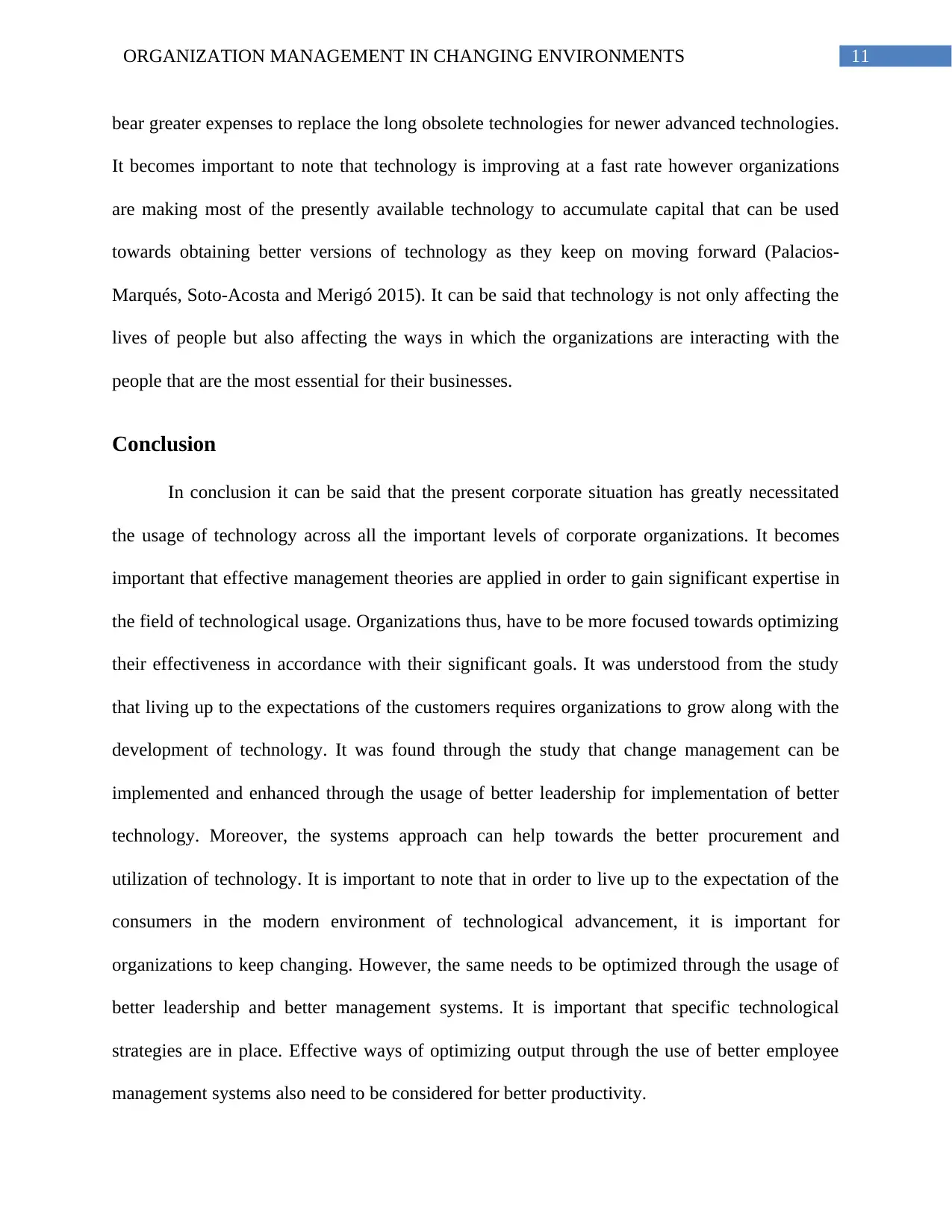
11ORGANIZATION MANAGEMENT IN CHANGING ENVIRONMENTS
bear greater expenses to replace the long obsolete technologies for newer advanced technologies.
It becomes important to note that technology is improving at a fast rate however organizations
are making most of the presently available technology to accumulate capital that can be used
towards obtaining better versions of technology as they keep on moving forward (Palacios-
Marqués, Soto-Acosta and Merigó 2015). It can be said that technology is not only affecting the
lives of people but also affecting the ways in which the organizations are interacting with the
people that are the most essential for their businesses.
Conclusion
In conclusion it can be said that the present corporate situation has greatly necessitated
the usage of technology across all the important levels of corporate organizations. It becomes
important that effective management theories are applied in order to gain significant expertise in
the field of technological usage. Organizations thus, have to be more focused towards optimizing
their effectiveness in accordance with their significant goals. It was understood from the study
that living up to the expectations of the customers requires organizations to grow along with the
development of technology. It was found through the study that change management can be
implemented and enhanced through the usage of better leadership for implementation of better
technology. Moreover, the systems approach can help towards the better procurement and
utilization of technology. It is important to note that in order to live up to the expectation of the
consumers in the modern environment of technological advancement, it is important for
organizations to keep changing. However, the same needs to be optimized through the usage of
better leadership and better management systems. It is important that specific technological
strategies are in place. Effective ways of optimizing output through the use of better employee
management systems also need to be considered for better productivity.
bear greater expenses to replace the long obsolete technologies for newer advanced technologies.
It becomes important to note that technology is improving at a fast rate however organizations
are making most of the presently available technology to accumulate capital that can be used
towards obtaining better versions of technology as they keep on moving forward (Palacios-
Marqués, Soto-Acosta and Merigó 2015). It can be said that technology is not only affecting the
lives of people but also affecting the ways in which the organizations are interacting with the
people that are the most essential for their businesses.
Conclusion
In conclusion it can be said that the present corporate situation has greatly necessitated
the usage of technology across all the important levels of corporate organizations. It becomes
important that effective management theories are applied in order to gain significant expertise in
the field of technological usage. Organizations thus, have to be more focused towards optimizing
their effectiveness in accordance with their significant goals. It was understood from the study
that living up to the expectations of the customers requires organizations to grow along with the
development of technology. It was found through the study that change management can be
implemented and enhanced through the usage of better leadership for implementation of better
technology. Moreover, the systems approach can help towards the better procurement and
utilization of technology. It is important to note that in order to live up to the expectation of the
consumers in the modern environment of technological advancement, it is important for
organizations to keep changing. However, the same needs to be optimized through the usage of
better leadership and better management systems. It is important that specific technological
strategies are in place. Effective ways of optimizing output through the use of better employee
management systems also need to be considered for better productivity.
⊘ This is a preview!⊘
Do you want full access?
Subscribe today to unlock all pages.

Trusted by 1+ million students worldwide
1 out of 16
Related Documents
Your All-in-One AI-Powered Toolkit for Academic Success.
+13062052269
info@desklib.com
Available 24*7 on WhatsApp / Email
![[object Object]](/_next/static/media/star-bottom.7253800d.svg)
Unlock your academic potential
Copyright © 2020–2025 A2Z Services. All Rights Reserved. Developed and managed by ZUCOL.





